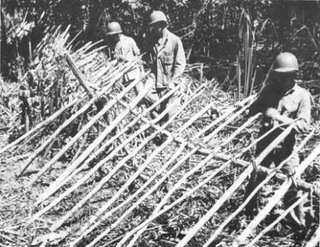
When ships carrying barbed wire and engineering tools needed ashore were forced to leave the Guadalcanal area because of enemy air and surface threats, Marines had to prepare such hasty field expedients as this cheval de frise of sharpened stakes.
Department of Defense (USMC) Photo 5157
zz##lllxxxx###%%%&&&+++===
###==##===climb under not over===#####----++####+++++
The Marines dug in along the beaches between the Tenaru and the ridges west of Kukum. A Japanese counter-landing was a distinct possibility. Inland of the beaches, defensive gun pits and foxholes lined the west bank of the Tenaru and crowned the hills that faced west toward the Matanikau River and Point Cruz. South of the airfield where densely jungled ridges and ravines abounded, the beachhead perimeter was guarded by outposts and these were manned in large part by combat support troops. The engineer, pioneer, and amphibious tractor battalion all had their positions on the front line. In fact, any Marine with a rifle, and that was virtually every Marine, stood night defensive duty. There was no place within the perimeter that could be counted safe from enemy infiltration.
Almost as Turner's transports sailed away, the Japanese began a pattern of harassing air attacks on the beachhead. Sometimes the raids came during the day, but the 3d Defense Battalion's 90mm antiaircraft guns forced the bombers to fly too high for effective bombing. The erratic pattern of bombs, however, meant that no place was safe near the airfield, the preferred target, and no place could claim it was bomb-free. The most disturbing aspect of Japanese air attacks soon became the nightly harassment by Japanese aircraft which singly, it seemed, roamed over the perimeter, dropping bombs and flares indiscriminately. The nightly visitors, whose planes' engines were soon well known sounds, won the singular title "Washington machine Charlie," at first, and later, "Louie the Louse," when their presence heralded Japanese shore bombardment. Technically, "Charlie" was a twin-engine night bomber from Rabaul. "Louie" was a cruiser float plane that signalled the harassed Marines used the names interchangeably.
No comments:
Post a Comment